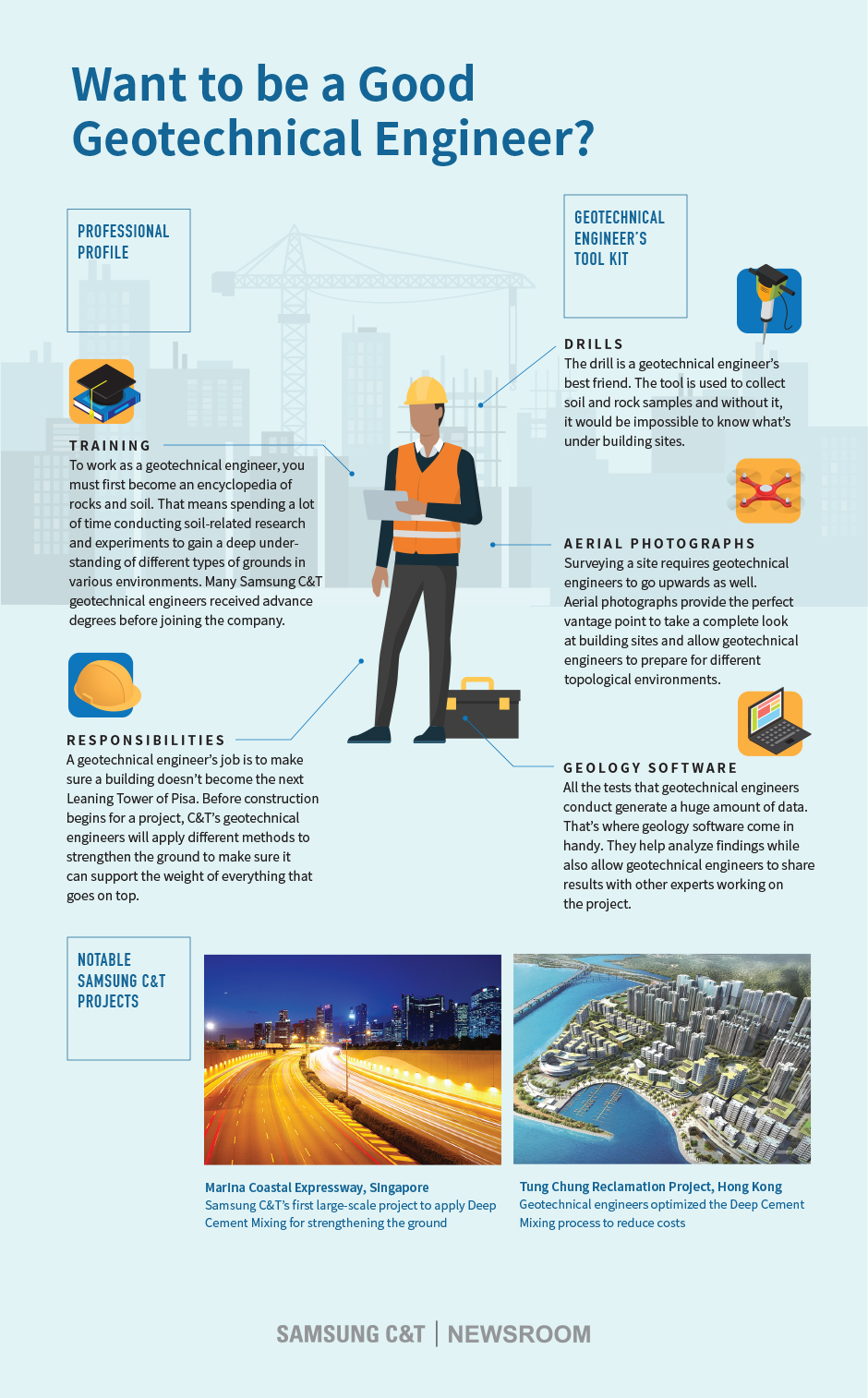Excitement About Geotheta
Excitement About Geotheta
Blog Article
Getting My Geotheta To Work
Table of ContentsSome Known Incorrect Statements About Geotheta Top Guidelines Of GeothetaOur Geotheta StatementsThe Facts About Geotheta UncoveredHow Geotheta can Save You Time, Stress, and Money.

They perform website examinations, collect samples, perform research laboratory examinations, and assess data to review the suitability of the ground for building jobs - Consulting Engineers. Based on their findings, geotechnical designers supply recommendations for structure style, slope security, preserving structures, and mitigation of geotechnical dangers. They collaborate with other specialists, such as architects, structural engineers, and building and construction teams, to guarantee that geotechnical considerations are incorporated into the total project layout and implementation
By assessing the actions and homes of dirt and rock, they can recognize possible geotechnical dangers such as landslides, soil negotiation, or slope instability. Their proficiency aids stop failures or accidents that could endanger lives and residential or commercial property. Right here are some detailed duties and responsibilities of a geotechnical designer: Website Examination: Geotechnical designers conduct site investigations to gather information on subsurface conditions.
They analyze the information to understand the residential or commercial properties and behavior of the soil and rock, including their strength, permeability, compaction characteristics, and groundwater conditions. Geotechnical Analysis and Layout: Geotechnical engineers analyze the data gathered throughout website examinations to examine the security and suitability of the website for construction tasks. They execute geotechnical estimations and modeling to review factors such as birthing capacity, settlement, slope stability, side earth stress, and groundwater circulation.
The 15-Second Trick For Geotheta
Foundation Style: Geotechnical engineers play a vital function in making structures that can securely sustain the desired structure. They evaluate the dirt problems and tons needs to determine the proper structure kind, such as superficial structures (e.g., grounds), deep foundations (e.g (https://www.awwwards.com/geotheta/)., heaps), or specialized techniques like dirt improvement. They take into consideration variables such as negotiation limitations, birthing ability, and soil-structure communication to establish optimal structure layouts
They examine building and construction plans, display website activities, and carry out area inspections to validate that the design referrals are adhered to. If unforeseen geotechnical concerns arise, they examine the circumstance and supply suggestions for remediation or adjustments to the layout. Danger Analysis and Mitigation: Geotechnical designers examine geotechnical risks and threats connected with the task website, such as landslides, liquefaction, or soil disintegration.

Cooperation and Communication: Geotechnical designers work very closely with various other professionals involved in a task, such as engineers, structural designers, and building and construction teams. Reliable communication and cooperation are necessary to integrate geotechnical factors to consider into the overall job style and building and construction process. Geotechnical engineers offer investigate this site technological know-how, response inquiries, and make certain that geotechnical demands are met.
The Best Guide To Geotheta
Below are some sorts of geotechnical designers: Foundation Engineer: Structure designers concentrate on creating and analyzing foundations for frameworks. They assess the soil problems, tons requirements, and website features to identify the most suitable structure kind and layout, such as superficial foundations, deep structures, or specialized strategies like pile foundations.
They assess the variables influencing slope security, such as dirt properties, groundwater problems, and slope geometry, and create methods to stop slope failings and minimize risks. Quake Designer: Earthquake engineers specialize in analyzing and designing frameworks to endure seismic forces. They examine the seismic threat of a website, assess dirt liquefaction capacity, and develop seismic design criteria to make certain the safety and security and resilience of frameworks throughout quakes.
They do area testing, accumulate samples, and examine the gathered data to define the soil properties, geologic formations, and groundwater conditions at a site. Geotechnical Instrumentation Designer: Geotechnical instrumentation engineers concentrate on surveillance and determining the habits of dirt, rock, and structures. They mount and preserve instrumentation systems that keep an eye on factors such as soil settlement, groundwater degrees, slope motions, and architectural variations to evaluate efficiency and offer very early warnings of possible issues.
The Best Strategy To Use For Geotheta
They carry out tests such as triaxial examinations, debt consolidation examinations, straight shear tests, and permeability tests to gather information for geotechnical analysis and layout. Geosynthetics Engineer: Geosynthetics designers specialize in the layout and application of geosynthetic materials, such as geotextiles, geogrids, and geomembranes. They use these products to enhance dirt security, strengthen inclines, provide water drainage solutions, and control erosion.
They tend to be investigatory people, which means they're intellectual, introspective, and curious. They are interested, systematic, reasonable, analytical, and rational. Some of them are also social, suggesting they're kind, generous, participating, client, caring, useful, empathetic, skillful, and pleasant - Geotechnical Engineers.
In the workplace environment, geotechnical engineers use specialized software tools to do estimations, create styles, and examine information. They prepare reports, review project requirements, communicate with customers and employee, and coordinate job tasks. The office setup supplies a favorable atmosphere for study, evaluation, and partnership with various other experts associated with the task.
Fascination About Geotheta
They regularly go to task sites to conduct website examinations, assess geotechnical conditions, and collect data for evaluation. These gos to entail taking a trip to various places, occasionally in remote or challenging surfaces. Geotechnical engineers may perform soil tasting, conduct tests, and monitor building and construction activities to make sure that the geotechnical facets of the job are being carried out properly.
Geotechnical designers additionally work in specialized geotechnical research laboratories. Geotechnical research laboratory engineers work extensively in these environments, managing testing equipment, operating tools, and tape-recording information.
Report this page